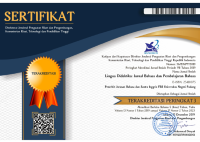AN INTERLANGUAGE ERROR ANALYSIS: A FORMATIVE EVALUATION FOR FRESHMEN
 ),
), (1) Univeritas Negeri Padang
 Corresponding Author
Corresponding Author
Copyright (c) 2017 Lingua Didaktika: Jurnal Bahasa dan Pembelajaran Bahasa
DOI : https://doi.org/10.24036/ld.v11i1.7938
Full Text:
 Language : en
Language : en
Abstract
Key words: Error analysis; Interlanguage; Target Modification Taxonomy;
ANALISA KESALAHAN INTERLANGUAGE: EVALUASI FORMATIF UNTUK MAHASISWA TAHUN PERTAMA
Abstrak
Artikel ini bertujuan untuk menemukan kesalahan interlanguage yang dibuat oleh mahasiswa baru atau tahun pertama Jurusan Bahasa Inggris Universitas Negeri Padang. Penelitian ini perlu dilakukan karena hasil darai penelitian ini bisa dijadikan sebagai evaluasi formatif dari dosen untuk mahasiswa tahun pertama. Penelitian ini adalah penelitian deskriptif kualitatif, didukung oleh perhitungan kuantitatif sederhana. Data berasal dari nilai ujian tengah semester mahasiswa. Jenis tes yang digunakan adalah pilihan ganda, melengkapi kalimat rumpang dan ujian menulis. Dalam ujian menulis, mahasiswa diminta untuk menulis satu buah paragraf. Ada 6 (enam) kelas yang terlibat dalam penelitian ini. Satu kelas diambil sebagai kelas sampel. Target Modification Taxonomy oleh James (1998) digunakan dalam menganalisa dan mendiskripsikan jenis kesalahan yang dibuat oleh mahasiswa. Penelitian ini menemukan bahwa jenis kesalahan yang paling banyak dibuat oleh mahasiswa adalah omission.
Kata Kunci: Error analysis; Interlanguage; Target Modification Taxonomy;
Keywords
References
Al-Khereseh, M. (2015). A review study of interlanguage study. International Journal of Applied Linguistics and English Literature Journal. 4(3), 124-131.
Ary, D., Jacobs, L. C., & Sorensen, C. K. (2010). Introduction to research in education (8 Ed). Wadsworth: Cengage Learning.
Brown, H. D. (2007). Principles of language learning and teaching (5Ed). New York: Longman.
Ellis, R. (1997). Second language acquisition. Oxford: Oxford University Press.
Gao., S. (2009). Policies for teachers toward errors in college English writing. International Education Studies. 2(2), 59-62.
Harmer, J. (2007). How to teach English. Harlow: Pearson.
James, C. (1998). Errors in language learning and use exploring error analysis. Harlow: Longman.
Jeptarus, E. K., & Ngene, P. K.-S. (2016). Lexico-semantic errors of the learners of English: Asurvey of standard Evev Keiyo- Speaking primary school pupils in Keiyo District, Kenya. Journal of Education and Practice. 7(13), 42-54.
Krashen, S. (1985). The input hypothesis: Issues and implications. Harlow: Longman.
McKay, P. (2006). Assessing young language learners. Cambridge: Cambridge University Press.
Ning, M. (2012). Implications of interlanguage error analysis and research on English language testing and teaching. Higher Education of Social Science Journal. 2(2), 4-7.
Pallotti, G. (2010). Doing interlanguage analysis in school contexts. In I. Bartning, M. Martin, & I. Vedder, Communicative Proficiency and Linguistic Developmen: Intersections between SLA and language testing research (pp. 159-190). Amsterdam: European Second Language Acquisition.
Skehan, P. (1994). Second language acquisition strategies, interlanguage development and task based learning. In M. Bygate, A. Tonkyn, & E. Williams, Grammar and the Language Teacher (pp. 175-200). New York: Prentice Hall.
Swan, M. (1994). Design criteria for pedagogic language rules. In M. Bygate, A. Tonkyn, & E. Williems, Grammar and the Language Teacher (pp. 45-55). New York: Prentice Hall.
Tiarina, Y. (2014). Grammar errors made by Microteaching students: A case at English Department. International Seminar on Language and Teaching (pp. 509-511). Padang: Sukabina Press.
 Article Metrics
Article Metrics
 Abstract Views : 1535 times
Abstract Views : 1535 times
 PDF Downloaded : 428 times
PDF Downloaded : 428 times
Refbacks
- There are currently no refbacks.
Copyright (c) 2017 Lingua Didaktika: Jurnal Bahasa dan Pembelajaran Bahasa

This work is licensed under a Creative Commons Attribution-NonCommercial 4.0 International License.









